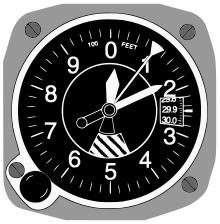Infrastructure tools to support an effective radiation oncology learning health system
Contents

An altimeter or an altitude meter is an instrument used to measure the altitude of an object above a fixed level.[1] The measurement of altitude is called altimetry, which is related to the term bathymetry, the measurement of depth under water.
Types
Pressure altimeter

Sonic altimeter
In 1931, the US Army Air Corps and General Electric tested a sonic altimeter for aircraft, which was considered more reliable and accurate than one that relied on air pressure when heavy fog or rain was present. The new altimeter used a series of high-pitched sounds like those made by a bat to measure the distance from the aircraft to the surface, which on return to the aircraft was converted to feet shown on a gauge inside the aircraft cockpit.[2]
Radar altimeter

A radar altimeter measures altitude more directly, using the time taken for a radio signal to reflect from the surface back to the aircraft. Alternatively, Frequency Modulated Continuous-wave radar can be used. The greater the frequency shift the further the distance travelled. This method can achieve much better accuracy than the pulsed radar for the same outlay and radar altimeters that use frequency modulation are industry standard. The radar altimeter is used to measure height above ground level during landing in commercial and military aircraft. Radar altimeters are also a component of terrain avoidance warning systems, warning the pilot if the aircraft is flying too low, or if there is rising terrain ahead. Radar altimeter technology is also used in terrain-following radar allowing combat aircraft to fly at very low height above the terrain.
After extensive research and experimentation, it has been shown that "phase radio-altimeters" are most suitable for ground effect vehicles, as compared to laser, isotropic or ultrasonic altimeters.[3]
Laser altimeter
Lidar technology is used to help navigate the helicopter Ingenuity on its record-setting flights over the terrain of Mars by means of a downward-facing Lidar altimeter.[4]
Global Positioning System
Global Positioning System (GPS) receivers can also determine altitude by trilateration with four or more satellites. In aircraft, altitude determined using autonomous GPS is not reliable enough to supersede the pressure altimeter without using some method of augmentation.[5] In hiking and climbing, it is common to find that the altitude measured by GPS is off by as much as 400 feet (122 metres) depending on satellite orientation.[6]
See also
- Acronyms and abbreviations in avionics
- ICAO recommendations on use of the International System of Units
- Flight instruments
- Flight level
- Hypsometer
- Jason-1 and Ocean Surface Topography Mission (Jason-2) are satellite missions that use altimeters to measure sea surface height
- Level sensor
- Lidar
- Pressure sensor
- Primary flight display
- Radar altimeter
- Satellite altimetry
- Turkish Airlines Flight 1951, an accident attributed to a malfunctioning radio altimeter
- United Airlines Flight 389, an accident attributed to misreading of an altimeter
- Variometer, a gauge measuring the rate of change of altitude
References
- ^ Wragg, David W. (1973). A Dictionary of Aviation (1st ed.). Reading: Osprey. p. 33. ISBN 0-85045-163-9.
- ^ "Meter Gives Elevation", Popular Science, March 1931
- ^ Nebylov, Prof. Alexander and Sharan Sukrit. "Comparative Analysis Of Design Variants For Low Altitude Flight Parameters Measuring System". 17th IFAC Symposium for Automatic Control.
- ^ "How NASA Designed a Helicopter That Could Fly Autonomously on Mars". IEEE Spectrum. 17 February 2021. Archived from the original on 19 February 2021. Retrieved 19 February 2021.
- ^ Albéri, Matteo; Baldoncini, Marica; Bottardi, Carlo; Chiarelli, Enrico; Fiorentini, Giovanni; Raptis, Kassandra Giulia Cristina; Realini, Eugenio; Reguzzoni, Mirko; Rossi, Lorenzo; Sampietro, Daniele; Strati, Virginia; Mantovani, Fabio (16 August 2017). "Accuracy of Flight Altitude Measured with Low-Cost GNSS, Radar and Barometer Sensors: Implications for Airborne Radiometric Surveys". Sensors. 17 (8): 1889. arXiv:1802.00327. Bibcode:2017Senso..17.1889A. doi:10.3390/s17081889. PMC 5579878. PMID 28813023.
- ^ "Understanding the Accuracy of the GPS Elevation Reading". Garmin. Archived from the original on March 5, 2020. Retrieved March 14, 2020.

















